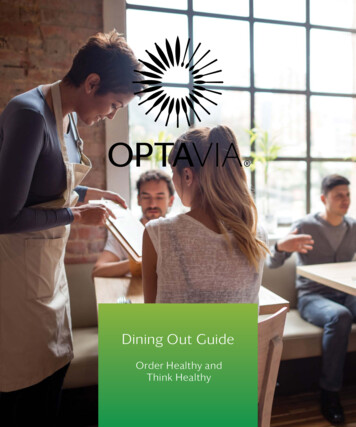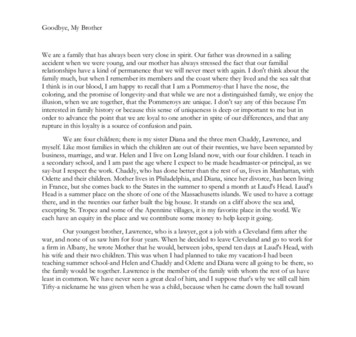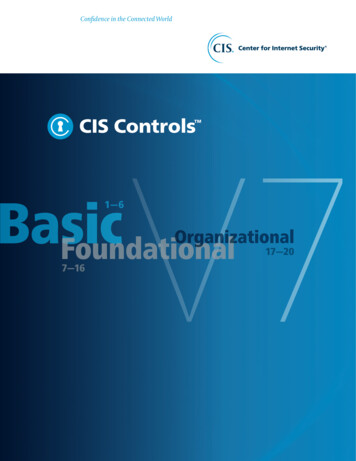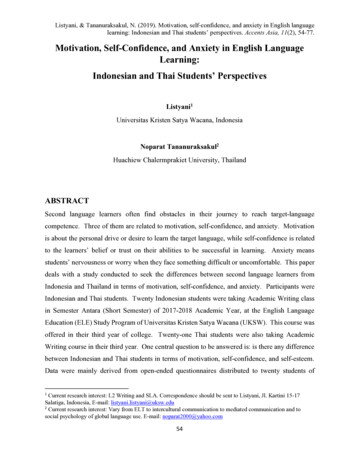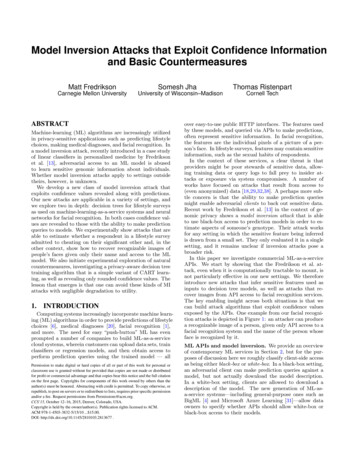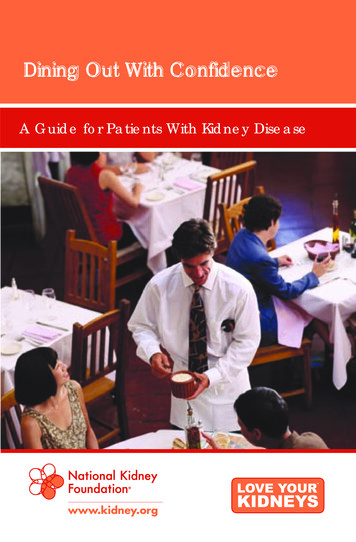
Transcription
Dining Out With ConfidenceA Guide for Patients With Kidney Diseasewww.kidney.org
National Kidney Foundation's Kidney DiseaseOutcomes Quality InitiativeDid you know that the National Kidney Foundation'sKidney Disease Outcomes Quality Initiative (KDOQI )has guidelines that help your doctor and healthcareteam make important decisions about your medicaltreatment? The information in this booklet is based onthe NKF-KDOQI recommended guidelines.What is your stage of kidney disease?There are five stages of kidney disease. They are shownin the table below. Your doctor determines your stageof kidney disease based on the presence of kidneydamage and your glomerular filtration rate (GFR),which is a measure of your level of kidney function. Yourtreatment is based on your stage of kidney disease.Speak to your doctor if you have any questions aboutyour stage of kidney disease or your treatment.Stages of Kidney DiseaseStageDescriptionGlomerular Filtration Rate (GFR)*1Kidney damage (e.g., protein inthe urine) with normal GFR90 or above2Kidney damage with milddecrease in GFR60 to 893Moderate decrease in GFR30 to 594Severe reduction in GFR15 to 295Kidney failureLess than 15*Your GFR number tells your doctor how much kidney function you have.As chronic kidney disease progresses, your GFR number decreases.2National Kidney Foundation
Table of ContentsIntroduction. . . . . . . . . . . . . . . . . . . . . . . . . . . . . . . . . . . . . . . . . . . . 4Guidelines for Specific Meals or CoursesBreakfast. . . . . . . . . . . . . . . . . . . . . . . . . . . . . . . . . . . . . . . . . . . . 6Beverages . . . . . . . . . . . . . . . . . . . . . . . . . . . . . . . . . . . . . . . . . . 7Salads and Salad Bars. . . . . . . . . . . . . . . . . . . . . . . . . . . . . . . . 8Appetizers. . . . . . . . . . . . . . . . . . . . . . . . . . . . . . . . . . . . . . . . . . . 9Entrées. . . . . . . . . . . . . . . . . . . . . . . . . . . . . . . . . . . . . . . . . . . . . 11Side Dishes. . . . . . . . . . . . . . . . . . . . . . . . . . . . . . . . . . . . . . . . . 12Desserts. . . . . . . . . . . . . . . . . . . . . . . . . . . . . . . . . . . . . . . . . . . . 14Specialized or Ethnic Restaurants. . . . . . . . . . . . . . . . . . . . . . . . 15Fast Foods. . . . . . . . . . . . . . . . . . . . . . . . . . . . . . . . . . . . . . . . . . . . 21Where can you get more information?. . . . . . . . . . . . . . . . . . . 23www.kidney.org3
IntroductionMost people enjoy eating out. This guide gives ideasfor making your dining experience fun—even with yourspecial diet. Start by learning your diet well and askingyour dietitian for any tips or advice. If you have sodium,potassium, phosphorus or protein restrictions, this bookletwill help you make good decisions based on yourspecific diet needs.Plan AheadIf you will be eating out for dinner, plan breakfast andlunch at home accordingly. Cut back on serving sizesand foods high in sodium and potassium during theday. Call ahead to learn more about the menu andhow the food is prepared. Explain that you are followinga special diet. Many restaurants now have websiteswhere they list their menus.Choose a restaurant where it will be easiest to selectfoods best suited for your diet. Restaurants where food ismade to order are the best choice. Restaurant personnelare accustomed to special requests for food items ormethods of preparation. However, many require that youcall at least 24 hours in advance to make arrangements.Making Your SelectionsLook over the menu carefully. Ask your server for moredetail about items you do not understand. Practicemaking special requests about the way your food isprepared or served. Consider sharing a main dish with afriend or family member.4National Kidney Foundation
Examples of Special RequestsFor salad dressings, gravies or sauces: “.on the side.” Forany grilled, sautéed or baked entrées: “No salt, please.”For Asian foods: “.with no MSG (monosodium glutamate).”For sandwiches or burgers: “.without cheese” or “Mustardand catsup on the side.”Protein ConcernsIf your specific diet includes a protein restriction, youmay want to request half portions of main dishesthat contain meat, poultry, fish or cheese. You couldshare a main dish with a dining companion. Anotheroption is to take part of your main dish home in atakeout box.Don’t forget that protein is found in cheese and creamsauces; food prepared with milk, nuts and eggs; and invegetarian dishes containing dried beans or lentils.www.kidney.org5
Guidelines for Specific Meals or CoursesBreakfast:Breakfast may be one of the easiest meals to eat out.Most restaurants offer à la carte breakfast items.BreakfastBetter Choices6Poor ChoicesEggs, cooked to orderCured or salted meats or fish,such as ham, sausage, lox andCanadian bacon. Limit baconto 2 strips occasionally.Omelets with low-potassiumvegetables, such as mushroomsor squashOmelets with cheese or abovemeats, fast-food breakfastsandwiches, breakfast burritosToast, bagels, English muffins,croissants, plain or blueberrymuffinsBiscuits and bran muffinsPancakes, waffles, French toastHome fries or hash brownpotatoesMargarine, jelly, honey,cinnamon, sugar andpancake or imitation syrupReal maple syrup or gravyLow-potassium fruits and juices,such as applesauce or applejuiceFruits and juices, such as orangejuice or a fresh grapefruit halfHot and cold cerealsBran cereals and granola withnuts, seeds or wheat germDonuts, fruit pastry, sweetrolls, coffee cakePastries containing chocolate,nuts, coconut or caramelNational Kidney Foundation
TIPSave your fluid quota throughout the day to allow more whenyou are eating out.Beverages:nnnnnnnPlan the amount of fluid you may have duringthe meal.Plan when you want the beverage: before, duringor after the meal. Decline offers at other times.Choose beverages low in potassium and phosphorus.(Ask your dietitian for specific guidelines.)Request that your glass or cup not be refilled. Orderbeverages by the glass instead of ordering a pitcherof drinks.Squeeze lemon wedges in your water to helpquench your thirst.Turn cups or glassesupside down beforethey are filled, or askto have them removed.Push your glass or cupaway from your platewhen you are finishedto avoid refills.www.kidney.org7
BeveragesBetter ChoicesPoor ChoicesCocktails mixed with club soda,ginger ale, tonic water or softdrinks (except colas)Cocktails mixed with fruit juice,tomato juice, vegetable cocktail, milk, cream or ice creamWine, red or white, if potassiumis counted (substitute for a fruit)BeerNon-cola soft drinks, such asSprite , 7UP or orange sodaAny colaIced tea or coffeeCocoa, milk, milk shakes,cocoa mixesLemonade, limeade, waterOrange juice-type drinks,tomato juice, vegetable juiceSalads and Salad Bars:nnn8.Salads are often part of the appetizer list. Use yourallowed fruits and vegetables for these choices.Request that the dressing be served on the sideso you can control the amount. Oil and vinegar isalways a good choice for dressing. You may bringyour own low-sodium dressing. Lemon or lime juicesqueezed generously over the salad can replacesalad dressing altogether.If they are not listed on the menu, ask the waiterwhich vegetables or fruits are in the salad.Often salads are preparedindividually, so you can usuallymake special requests. Someexamples are listed on thefollowing chart.National Kidney Foundation
SaladsBetter ChoicesPoor ChoicesLettuce, cabbage, beets,cauliflower, celery, cucumber,jicama, onions, beans, greenpeas, radishes, sprouts,sweet peppersSpinach, tomato, avocado, artichoke, kidney beans, garbanzobeans, seeds, nutsColeslawPotato saladBeet saladThree-bean saladPasta salad, macaroni saladGreek salad with olives,relishes, picklesFruit cup or salad: canned fruitcocktail, canned peaches orpears, fresh or cannedpineapple, mandarin orangesSalad containing melon,oranges, bananas, kiwi,dried fruitGelatin salads (plain or withlow-potassium fruits or vegetables added)Appetizers:nnLook for fresh, simple items to avoid a heavy salt orfluid load before your meal.A high-protein appetizer can be used as yourmain course. Portions are usually smaller andless expensive. Some examples are listed on thefollowing chart and will vary with the type ofrestaurant.www.kidney.org9
AppetizersBetter ChoicesPoor ChoicesCaesar salad with chickenor shrimpCottage cheese, cheese fondue,other cheese dishes, anchoviesChicken, pork or steak tostadasQuiche, cheese sticksCrab cakes, steamed clams,fried calamari, mostshrimp dishesOystersCrab Louis saladGreen salad with meat or fishor chef's salad without ham orcheese (request dressing onthe side)Nachos, potato skinsChopped liver or pâté; salted orsmoked meat, fish or poultry, suchas ham, lox or smoked turkey;soup, bouillon or consommeOthers: meat balls, chicken wings,pot stickers and dumplings (withoutdipping sauces), fried zucchini,mushrooms or onion rings10National Kidney Foundation
Entrées:nPortions served in restaurants may be much largerthan what you eat at home. When dining out,estimate an amount close to what you normallyhave. Plan to take the remainder home, or split themeal with another person in your group.TIPThree ounces of cooked meat, fish or poultry is about the sizeof a deck of cards. Or, if you weigh meat portions at home,measure them against your hand to use as a guide wheneating away from home.nnnnnnnGrilled items are good choices because you canrequest how you want them prepared.Request that salt not be added when cooking.Request that gravies or sauces be served onthe side.Avoid mixed dishes or casseroles, which are usuallyhigher in sodium and phosphorus.Remove the skin from poultry and any crusts fromfried foods to decrease sodium content.It is best NOT to add steak sauce, Worcestershiresauce, soy sauce or hot sauce because of the highsodium content.Lemon or lime juice and vinegar make good saucesand will bring out a lot of the natural flavor of foods.Black pepper will add zest to the food withoutmaking you thirsty.www.kidney.org11
EntréesBetter ChoicesPoor ChoicesBeef (broiled or grilled steaks,burgers without cheese, primeribroast or hot roast beefsandwiches), chicken (baked,fried, grilled or roasted), leg oflamb, lamb chops, veal, meat loafMixed dishes, beef or lamb stew,liver and onions, cured or saltedmeats (ham, corned beef,sausage, prosciutto, chorizo)Fish or seafood (grilled, steamedor poached)Bouillabaisse, oysters, lobsterNewburg, loxSeafood or meat kabobsSauces (especially cheese ortomato), graviesFajitas, meat or chicken tacos (nocheese or tomatoes)Bean dishes, chili beans, chilicon carneOmelets with allowed vegetablesand sauce served on the sideOmelets with bacon, cheese,ham, sausageSandwiches (request no cheese):roast beef, chicken, egg, turkey,hot roast beef or turkey, freshseafood sandwichSubmarine sandwiches,toasted cheese, BLT, baconhamburger, Reuben, tuna(canned) saladSide Dishes:The more familiar you are with your diet, the easier itwill be to choose appropriate foods. It might be wise toreview your food lists before going out.n12Choose starches and vegetables that are lower inpotassium, such as rice, noodles and green beans.nRequest a substitute on the menu if necessary.nAsk that sauces be omitted or served on the side.National Kidney Foundation
TIPTo increase your choices, avoid higher-potassium fruits andvegetables during the day before eating out.Side DishesBetter ChoicesPoor ChoicesNoodles or pasta, pesto pasta,macaroni saladPasta in tomato sauceSteamed rice, rice pilaf,rice with peasYams, sweet potatoes, fried rice,white potatoesUnsalted breadsticks,bread or rollsBaked or barbecued beans,refried beans (frijoles)Lower-potassium vegetables, likeasparagus, cabbage, cookedcarrots, corn, eggplant, greenpeas, zucchini, corn on the cob,coleslaw, lettuce saladHigher-potassium vegetables,like tomatoes, spinach, collardgreens, artichokes, acornsquash and others.High-sodium vegetables likesauerkraut, pickled vegetableswww.kidney.org13
Desserts:nnnnAsk for a clear description of the dessert. Choosefrom those desserts that have simple preparations toavoid “hidden” phosphorus and potassium.Choices with chocolate, cream cheese, ice creamor nuts will be much higher in potassium andphosphorus. Avoid these, share with a friend or justeat a small amount.Remember, desserts, such as fruit ice, gelatin, sorbetand sherbet, add to your fluid intake for the day.Sweets may or may not be desirable for you. Alwaysfollow the advice of your dietitian, who is morefamiliar with your individual needsDessertsBetter ChoicesAngel food, apple, lemon,pound, spice, white or yellowcake may be topped withwhipped cream and lowpotassium fruitSugar cookies, Lorna Doones ,vanilla wafers, lemon cremeand butter cookies14Poor ChoicesCakes rich in chocolate, coconut, dried fruit or nuts, such ascarrot, chocolate mousse,devil’s food, fruit or Germanchocolate cakeBrownies, chocolate, coconutmacaroons, snickerdoodlesFruit ice, sherbet, sorbetIce cream or frozen yogurtLower-potassium fruit dessertslike berries, strawberryshortcake, gelatin dessertsFruits higher in potassium likebananas, oranges or kiwiPies, tarts or cobblers madewith apple, blueberry, cherry,lemon meringue or strawberryPies like banana cream, chocolate cream, coconut, mincedmeat, pecan, pumpkin, sweetpotato or cheesecakeNational Kidney Foundation
TIPRemember to take your phosphate binder (also called aphosphorus binder) with your meal. Be sure to carry it withyou, and keep some in the car so it is always easily available.Specialized or Ethnic Restaurants:An enjoyable aspect of eating out is trying differentethnic and regional foods. Follow these suggestions formaking wise choices.Chinese Caution: May be very high in sodium.nRequest no MSG (monosodium glutamate), soy orfish sauce in food preparation. (The menu mayinclude this information.)www.kidney.org15
nnnnnnnAvoid restaurants that cook in “bulk”; look for thosethat prepare foods individually. You may call inadvance to get this information.Avoid adding soy sauce to the food after it is served.Most Chinese restaurants will provide a hot pepper oil.This can be added to make the food spicier, if desired.Soups served with the meal are usually high insodium and may add undesired fluid weight.Choose lower-potassium vegetables, such as snowpeas, string beans, water chestnuts, bean sproutsand bok choy. Request stir-fried vegetables that arenot served in heavy sauces.Steamed rice is more authentic and has less sodiumthan fried rice.The tea is often served in a pot on the table. Controlthe amount poured into your cup to help controlyour fluid weight gain.Enjoy your fortune cookie knowing you have madethe best choices.French Caution: May be very high in phosphorus.nnn16French restaurants usually use fresh ingredients, butcream and butter may be added in large amounts.Try to avoid those foods prepared in cheese orcream sauces. Careful questioning of the waiter canhelp you make your decision.Choose low-potassium fruits and vegetables,and avoid the high-potassium fried potatoes(pommes frites).National Kidney Foundation
nnnFrench bread is a good choice, low in sodium,potassium and phosphorus. The butter served isusually “sweet” or unsalted.Select a simple, light vinaigrette for salad dressing.Desserts are always a highlight. Look for delicioussorbets (count as fluid), cakes, meringues or fruits,such as plums, berries or cherries, that are notin heavy cream sauces or thickly covered withchocolate.Mexican Caution: May be very high in potassium.nnnnnPut aside the chips and salsa that might be at thetable when you first sit down. Save the sodium andpotassium for your meal.Order à la carte, or select entrées that are notserved with beans and Spanish rice. Some gooditems are tacos, tostadas and fajitas.Beware of the salsas used. Salsa verde is a greensauce but is made of green tomatoes. Salsas madeof chili peppers without tomatoes added are thebest choices. Remember, guacamole is made fromavocados, which are very high in potassium.Tortillas are good bread substitutes. Enjoy them!For dessert, try the sopapillas (fried dough) withhoney, which are a good choice because they arelow in potassium and phosphorus. Pastries are highin saturated fat, however, so make sure to eat themin moderate portions.www.kidney.org17
Asian Indian Caution: May be very high in phosphorus.nnnnnnIndian meals are often vegetarian. While it is best toavoid the bean dishes, there are many otherdelicious foods to choose from.Enjoy experimenting with different flavors.Masala, tandoori and curry preparations arewidely available on menus as both chicken andvegetable entrées.Remember to ask which vegetables are includedin dishes, and make low-potassium choices. Askyour dietitian for a list of low-potassium vegetablesand vegetables to limit. (See National KidneyFoundation’s A to Z Health Guide: Potassium andYour CKD Diet.)Yogurt is often served as a side dish or part of sidedishes, but remember it is a dairy food and highin phosphorus.A large selection of Indian breads, such as fried,baked or roasted varieties are served with mostmeals or are available as separate orders.Most desserts contain milk or milk powder in therecipe and will be high in phosphorus. Rememberto take your phosphate binder.Italian Caution: May be very high in potassium.n18Beware of the antipasto appetizer that containssalty sausages and pickled or marinatedvegetables. These foods could get your meal off toa salty, high-fat start. Also, pass on the minestronesoup, which is high in salt and potassium.National Kidney Foundation
nnnnnnRequest an oil and vinegar dressing for the salad.Italian bread is a good bread choice. Dippingthe bread in olive oil is a healthy alternative tospreading it with butter because olive oil containsheart-healthy fats compared to the high animalfats in butter.Tomato sauces are poor choices, but pastas areserved with many sauces that are not tomatobased. If you do select one with tomato sauce,request that it be served on the side. Limit cheeseand white sauces.If you choose pizza, look for a light or vegetariantopping, and request that the tomato sauce andcheese be used lightly. It is best to avoid pepperonior sausage pizzas, which are high in sodium. Otheravailable toppings may include chicken or fish,both good choices.One tablespoon of shredded Parmesan or Romanocheese .may be used for flavor. Pepper flakes may beused liberally.Italian ices are good dessert choices, butremember to count them as fluid.Japanese Caution: May be very high in sodium.nnAvoid the salty soups, like miso, served at thebeginning of the meal.Request no MSG (monosodium glutamate) andavoid the soy sauce.www.kidney.org19
nnnnSushi can be a good choice, as portions are small.Avoid raw fish choices, as they may expose you toparasitic infections. Other rolls available includecucumbers and cooked shrimp, crab or eel.Try the yakitori, or food grilled on skewers over acharcoal fire. Foods fried in tempura batter aregood choices if not dipped in high-sodium sauces.Tofu, or soy bean curd, is used regularly in Japanesecooking. It is substituted for meat in the kidney diet.Be aware that it is often cooked with soy sauce foradded flavor.The Japanese steak house offers good choices ofgrilled meat and vegetables, but portions maybe large.Soul Food Caution: May be high in sodium, potassiumand phosphorus.nnnn20Soul food is very challenging to the kidney dietbecause it is frequently high in sodium, potassiumand phosphorus, as well as fat.Salted and cured meats, such as ham, sausages,bacon and salt pork should be avoided. Baconand bacon fat are used extensively in the cooking.Organ meats, such as chitterlings, are higher inphosphorus than cuts of muscle meat. Limit these tooccasional use.Dried beans and black-eyed peas are high inphosphorus and potassium. Limit these to smallamounts (1–2 tablespoons).National Kidney Foundation
nnnCooked greens and spinach are popular. Both arehigh potassium vegetables. Mustard greens areslightly lower in potassium.Yams and sweet potato pie are high in potassium.Best choices might include fried chicken (with skinremoved), corn, string beans or okra, wilted lettuce,corn bread, butter and banana cake, apple cakeor peach cobbler for dessert. Enjoy, and don’tforget your phosphate binders.Fast Food:Eating at fast-food restaurants is not totally out ofthe question. It does, however, take some thoughtand planning. While many fast-food items are presalted, there may be some items that are preparedwithout the salt. You can also omit the high-sodiumcondiments, such as BBQ or soy sauce, and limitothers, such as catsup to one package.Many fast-foodrestaurants providenutrition informationso you can check thesodium and potassiumcontent. Your kidneydietitian can also providethis information and tellyou the specific amountsof sodium and potassiumallowed in your diet.www.kidney.org21
Fast FoodPoor ChoicesBetter Choices22Regular or junior-sizehamburgersLarge, super- or king-sizehamburgers or cheeseburgersRoast beef orturkey sandwichesSandwiches with bacon,sauces or cheeseGrilled or broiled chickensandwiches, tuna orchicken saladFried or breaded chickensandwiches, chicken nuggetsor stripsUnsalted onion ringsFrench fries, Tater Tots , potatochips, baked potato, potatosalad, baked beansLettuce salads, coleslaw,macaroni saladHigh-potassium foods fromthe salad bar or pickles;limit tomatoesNon-cola soda, lemonade,tea and coffee, waterMilk shakes and cola sodasNational Kidney Foundation
Where can you get more information?ichron1–4)nd Con a (StagesNutritiiseaseey Ded?Kidnu Netingu GettWhad KidneyNutrition an ge 5)Failure (StaYou Need?ting WhatAre You GetKeepDiabetes and Your Eyes, Heart,Nerves, Feet and KidneysYoYoAreWhatWinning theFightAgainst Silent Killers:High Blood PressureWhening YourHeartYou ShHealthouldyKnowAboutLipidsYou Have ChronicKidneand Diabetesy Disease Stages 1–4www.kidney.orgorgwww.kidney.orgidneywww.kIf you have questions, speak with your healthcare team. They knowyou and can answer questions about you.If you want to read more about kidney disease, the NationalKidney Foundation has more than 50 other publications thatcover many subjects such as:nCKD risk factors like hypertension and diabetesnComplications of chronic kidney disease, such ascardiovascular disease, anemia or bone problemsnNutrition for CKD patients with information aboutcarbohydrates, protein, sodium, phosphorus and potassiumnTreating kidney disease earlynTreating kidney failure with transplantation or dialysis.There are two ways to learn about the many free resourcesavailable to you:nCall the National Kidney Foundation at 800.622.9010.nVisit the National Kidney Foundation website(www.kidney.org/store).All publications are free, but there is a limit of five per person.Becoming an educated patient is very important to beinghealthy!www.kidney.org23
National Kidney FoundationThe National Kidney Foundation (NKF) is dedicated to preventing kidney diseases,improving the health and well-being of individuals and families affected by thesediseases and increasing the availability of all organs for transplantation.With local offices nationwide, the NKF provides early detection testing and othervital patient and community services. The Foundation conducts extensive public andprofessional education, advocates for patients through legislative action, promotes organdonation and supports kidney research to identify new treatments.In 2009, NKF launched a groundbreaking multifaceted collaborative initiative to“END THE WAIT!” for a kidney transplant in the United States in 10 years by using provenstrategies to eliminate barriers to donation and institute best practices across the country.The NKF relies on individual and corporate donations, foundation and government grants,membership and special events to support its range of programs, services and initiatives.National Kidney Foundation30 East 33rd StreetNew York, NY 10016800.622.9010www.kidney.orgWe proudly state that this publication is printed on recycledpaper that contains 10% post-consumer waste. The paperis also Forest Stewardship Council (FSC) certified whichguarantees it is made from trees that come from carefullymanaged and responsibly harvested forests that adhere tostrict environmental and socioeconomic standards. Pleaserecycle this publication when you are finished with it. 2010 National Kidney Foundation, Inc. All rights reserved. 11-10-0405 HBA
The more familiar you are with your diet, the easier it will be to choose appropriate foods. It might be wise to review your food lists before going out. n Choose starches and vegetables that are lower
